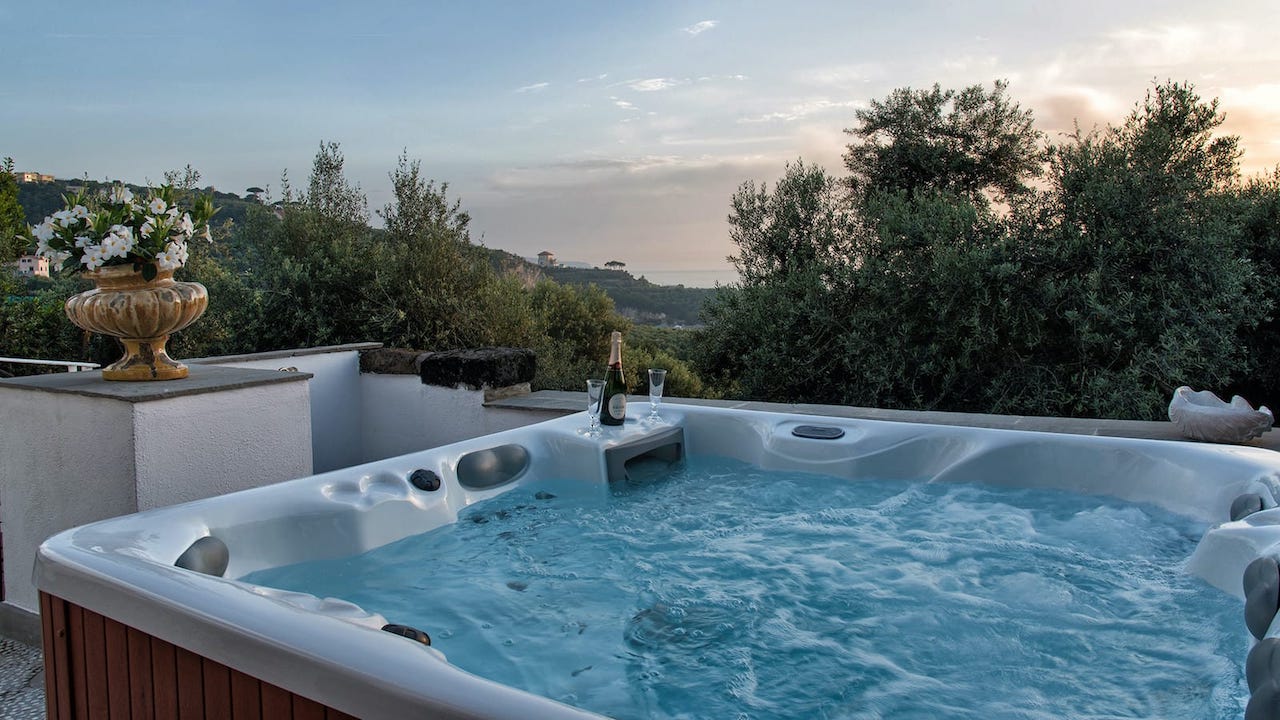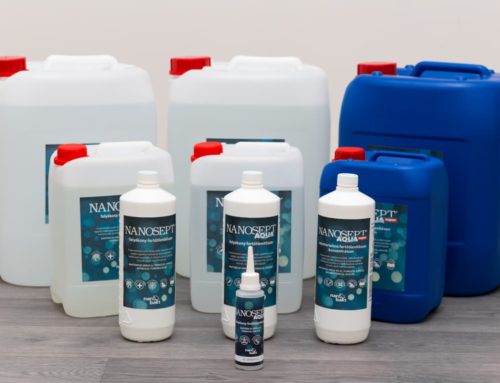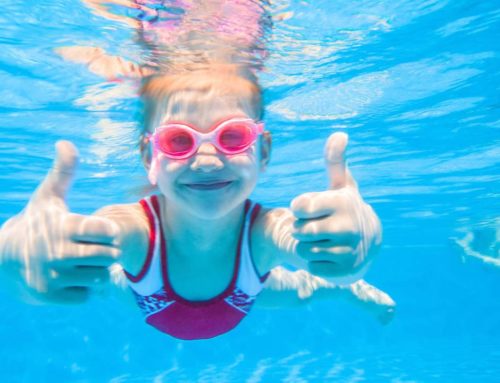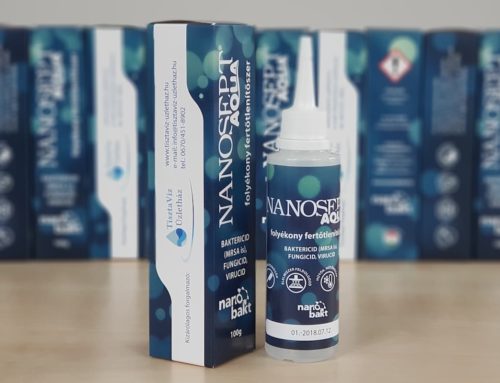Continuous treatment is required to keep whirlpools, jacuzzis, and other pools and bathing waters constantly clean. The method and frequency of treatment are influenced by the different types of pools, their size, the habits affecting their use, and other circumstances, so their use according to the protocol is difficult to describe, in each case it can be said to be unique. The disinfection steps are given according to the need to keep the amount of disinfectant in the water at the required level.
Disinfection with Nanosept Aqua disinfectant
Nanosept Aqua disinfectant kills microorganisms in the pool water (bacteria, fungi, algae, viruses). Some of its microorganisms can cause diseases and infections when they spread in water, and when they multiply, the pool water can become cloudy and opaque. Bathing water must have sufficient disinfectant to kill the microorganisms in the water, but it must not yet be harmful to the health of bathers. Please check the safety data sheet of the product before use and read it carefully!
It is important not to use the disinfectant together with other chemicals! Dosing must be carried out in a suitable protective device.
Nanosept Aqua contains 5% (50,000 mg / l) hydrogen peroxide and 500 mg / l silver colloid.
Our Nanosept Aqua product does not qualify as dangerous goods covered by ADR during transport, but this does not mean that it does not have dangerous properties, so the instructions in the product safety data sheet must be observed during handling (transport, storage, use)!
ATTENTION!
Also required by authorities:
When used in bathing water, bathing water may contain a minimum of 20 mg / l and a maximum of 100 mg / l of hydrogen peroxide. This active ingredient in the product is easily measurable.
During bath water disinfection it is necessary to maintain the concentration of 30-45 mg / l hydrogen peroxide in bathing water, the 100 mg / l hydrogen peroxide concentration is used for shock treatment, in case of such high concentration water is temporarily not used for bathing until partial decomposition, it may cause skin irritation in children!
Steps for treating pool and jacuzzi water with NANOSEPT AQUA disinfectant
- Pre-cleaning and disinfection of the surface of the pool and jacuzzi (e.g. sprayed with a 10-fold dilution of Nanosept Aqua, rinsing after the exposure time).
- Pool, jacuzzi filling with bath water, so that the pool, jacuzzi approx. When filling to 1/3, add disinfectant. It is recommended to use 1000 ml of Nanosept Aqua for 1 cubic meter of water. (this will result in an initial concentration of 50 ppm).
- We fully fill the jacuzzi.
- The disinfectant is completely mixed in the water with the water circulator. Knowing the capacity of the water circulator, the water must be circulated until the total amount of water in the jacuzzi is circulated at least once.
- Water quality control, determination of hydrogen peroxide concentration.
Attention: when re-commissioning an unused pool or in the case of a loaded, intensively used pool, it is recommended to start with a shock treatment (filling the experience elements), ie. using 2000 ml of Nanosept Aqua per 1 m3 of water, depending on the load, hydrogen peroxide concentration 12-24, keeping at a concentration of 100 ppm for -48 hours. In this case, the pool should not be used until the concentration has dropped back to a bathing concentration, ie. 30-45 mg / L.
It is generally advisable to carry out water quality monitoring at least once a week, as a routine work associated with each water use habit.
The easiest way to perform a measurement is to use a test strip to determine the concentration.
Name Prices
test strip measuring 0.5-25 ppm HUF 9,920.00
test strip measuring 1-100 ppm HUF 9,920.00
test strip measuring up to 50-1000 ppm HUF 13,600.00
The test strip with the measuring range most commonly used for pool water disinfection is the test strip measuring from 1 to 100 ppm.
Maintaining the optimal concentration of NANOSEPT AQUA disinfectant, adjusting and replacing the hydrogen peroxide concentration.
If the measured hydrogen peroxide concentration is below the optimal hydrogen peroxide concentration, the amount between the two can be adjusted by further addition of NANOSEPT AQUA. The amounts required to increase the concentration are given in the table below:
| Víz mennyiség (m3) | Hidrogén- peroxid koncentráció növelése (mg/l = ppm) | Nanosept Aqua mennyisége (ml) |
| 1 m3 | 10 ppm | 200 ml |
| 1 m3 | 20 ppm | 400 ml |
| 1 m3 | 30 ppm | 600 ml |
| 1 m3 | 40 ppm | 800 ml |
| 1 m3 | 50 ppm | 1000 ml |
| 1 m3 | 60 ppm | 1200 ml |
| 1 m3 | 70 ppm | 1400 ml |
| 1 m3 | 80 ppm | 1600 ml |
| 1 m3 | 90 ppm | 1800 ml |
| 1 m3 | 100 ppm | 2000 ml |
For pools with a larger volume, the amount of Nanosept Aqua disinfectant for the given hydrogen peroxide concentration must be multiplied by the volume (m3).
Example:
When adjusting a 2.5 m3 jacuzzi to 40 ppm hydrogen peroxide: 2.5 (m3) x 800 (ml) = 2000 ml Nanosept Aqua is required.
Attention! Depending on the load on the water (use), the composition, pollution and temperature of the water, the hydrogen peroxide content of the water may decrease over time. Therefore, the hydrogen peroxide content of the water must be checked regularly!
If the hydrogen peroxide concentration has decreased, it must be readjusted to the appropriate level by adding additional disinfectant. To adjust to the correct level, it is necessary to recirculate the water so that the disinfectant added to the water is completely mixed. If the water or a part of it needs to be replaced, its disinfectant content needs to be replaced after filling, so that we can maintain the proper quality of the water.
Algae removal
NANOSEPT AQUA disinfectant can inhibit the growth of algae, which are common in swimming pools, by keeping them at the right level.
Algae feed on phosphate, a nutrient used for filling water, urine, household cleaners, and so on. gets into the water. Their reproduction requires the right temperature (warm) and sunlight in addition to the algae spores that get into the water with rain and wind. In general, if it is not properly maintained, if the level of disinfectant is low, even a short time is enough for the pool to become warm, in which case the water may experience greening.
In such cases, immediate shock treatment should be applied, allowing the water to turn brown (from the dead algae), which can be purified by vacuuming and continuous filtration.
Further suggestions for operation to consider
At outdoor pools, it is sometimes worthwhile to shock even for prevention!
During the summer, it is worthwhile to rotate the bathing water more, because the stagnant water will turn green sooner and the algae will grow faster under the influence of strong sunlight.
During the winter, the water level must be lowered under the skimmer and the blowers, and water must also be drained from the pipelines to avoid possible freezing and pipe rupture. The water circulator should be stored in a frost-free place to prevent algae build-up in the pool water, it is recommended to add NANOSEPT AQUA disinfectant for 2-3 times shock treatment.
In the case of above-ground foil pools, we recommend that do not drain the water completely during the winter, as the foil may be damaged and ruined.
Flocculation
Filters are not always able to filter out small contaminants floating in pool waters. The water in the pool can become cloudy, opaque, which can only be removed by adding flocculants so that the tiny particles collect in flakes of a larger size, i.e. they will be multiples of the original size, so they eventually get stuck on the filter.
It is important to determine the cause of the turbidity. Use a flocculant only if the pH of the bath water and the amount of disinfectant are adequate and yet the water is opaque.
In this case, water must be disinfected in parallel with the addition of the flocculant, and continuous filtration must be ensured. In general, a flocculant can be added to the bath water a few weeks after filling.
Other information
It is important to mention that bathing water does not correspond to the quality of drinking water, they may contain significantly higher concentrations of disinfectant active ingredients.
The concentration of disinfectant in bathing waters is recommended in accordance with the legislation and product authorizations, other uses may pose a risk hazard: in the case of low doses they are ineffective, in case of overdose the risks caused by the active ingredients of the disinfectant endanger safe use.
When determining the active substance content of disinfectants laid down in the legislation, the legislators take into account that bathing waters are subject to load, bathers can stay in them for a long time, they can sip randomly from the bathing water. The limits are set so that when used in bathing water, the amount of disinfectant blended in it must not cause irritation to mucous membranes, eyes and skin.
However, ingestion is not recommended as disinfectants primarily maintain bathing water from a microbiological point of view, the active ingredients of disinfectants may affect the normal intestinal flora of the digestive system. Moreover, other contaminants (physical, chemical) may be present in the bathing water.
The continuous maintenance of pools and bathing waters, regardless of volume, takes a lot of time, energy and costs. The disinfection procedure always requires a professional level of thinking, we try to help this thinking with our information so that they are satisfied with the use of our products.
Types of pools
Pools can be of many types according to their type (e.g. according to pool structure, according to water circulation technologies).
Based on their properties influencing the method and frequency of treatment, they can be:
- different in location (indoor or outdoor);
- Different in terms of cover (e.g. without cover, solar, safety, roller shutter, made of polycarbonate, with winter pool cover film, cover, etc.);
- equipped with accessories (e.g. experience elements, water flowing in the case of whirlpools, etc.);
- according to their composition, filled with water with local characteristics (e.g. drinking water (mains) water, possibly softened water, or well water of variable composition and quality with a high metal content (e.g. iron), in which case the use of demetallizing agents is recommended);
- pools with longer, shorter difficult-to-clean pipelines, etc .;
- different in terms of water circulation (sunken or stretched water mirrors);
- differ according to the pool structure (prefabricated or reinforced concrete pools with different coverings, etc.).
Pools can vary greatly in size and usage within a given type, as a larger pool that can be used continuously by more people requires more maintenance, while the maintenance of smaller pools is not negligible either.
Other conditions, such as adequate (physical, chemical, microbiological) quality and temperature of the bathing water (which is also affected by the ambient temperature), varying quantities and qualities of physical, chemical and microbiological loads (pollutants), mains water, washed by rainwater, depending on personal hygiene. In the case of other added substances (for example, the amount of chlorine in mains water), they strongly influence the amount and effectiveness of the disinfectant.
In general, when disinfecting pool water, the principle is acceptable (also approved by the authorities) that the concentration of disinfectant in the pool water should be kept constant.
Elements of maintenance of whirlpools, jacuzzis, other pools
Cleaning
The warmer temperature of the bathing water promotes the growth of microorganisms, and the organic contaminants that form their food also enter the body of bathers, e.g. residues of fats, soap derivatives, bath oils, ointments. The infestation process in pool water continues even when the pool is not in use. A mucous layer, i.e. a biofilm, is formed on the surface of the pool and in the pipe system, in the water circulating filter. This can be removed from the surface of the pool relatively easily, however, the rest of the system cannot be cleaned mechanically at all, only with proper disinfection.
Filtration
When keeping the pool water clean, it is important to remove dirt and mix the chemicals with the help of a water circulator. The water circulating unit consists of a pump and a filter with a different charge, which is primarily responsible for filtering contaminants floating in the water. An underwater vacuum cleaner is used to remove dirt that settles on the bottom of the pool.
pH
Bathing water can be clear and transparent with the right chemical balance. It is also necessary to ensure that the optimal pH of the bathing water, i.e. the pH value, is maintained between 7.2 and 7.6. The pH can be checked with several water analysers (measuring strip, digital analyser, etc.). After measurement, the value obtained can be adjusted to the appropriate value by adding pH-lowering or pH-increasing agents.
Water hardness
The amount of calcium and magnesium salt dissolved in water determines the hardness of the water. Hard water contains a lot of these salts, limescale can form on the pool wall, pipelines, sand filters, and in the case of improperly disinfected, loaded water, it can also serve as a favourite habitat for microorganisms.
It is important that after the regeneration of the different types of plasticizers used to bind the salts dissolved in water, they should be washed thoroughly because residues in the softened water (e.g. chloride ions from sodium chloride and calcium and magnesium ions washed from the resin) may form a complex with silver in NANOSEPT AQUA disinfectant (e.g. silver chloride, which may turn gray when exposed to precipitation).
Warranty
Nanobakt Kft. guarantees that its products comply with the parameters indicated in the certificate of work attached to the goods. The company guarantees the quality of the products sold according to the legislation in force at any time or for the period specified by the manufacturer (taking into account the specifics of each material), in accordance the Civil Code.
The Supplier does not warrant that the Goods are suitable for any special purpose not mentioned in the documents or instructions accompanying the Product and / or not described on the Website, unless expressly agreed to this in writing.
Nanobakt Kft. undertakes the suitability of the goods delivered by it for a purpose beyond the general use requirements within the scope of use only if it has agreed in advance with the buyer in writing.
Individual, special needs, conditions must be clearly indicated.
Our oral and written application information are based on extensive research. We give advice to the best of our knowledge, but without obligation, as we cannot influence the conditions of use and storage of the product.
We do not accept any liability for any damage that may occur due to improper use of the product!
In case of any questions, our colleagues will be happy to provide information!
Nanobakt Kft.
Tel.: +36 20 29 29 29 7
Mon-Fri 8: 30-15: 30
info@nanobakt.hu



